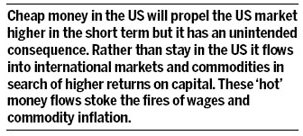Is a second meltdown approaching?
Updated: 2011-07-18 11:05
By Daryl Guppy (China Daily)
|
|||||||||||
Three things point to a very gloomy outlook for the economy

The soup includes the implosion of the eurozone with its attendant threats of default from Greece, Italy and Portugal. The feisty Greek protests provide more television drama, but this only diverts attention from the wider problem.
The soup mixture includes a collection of alphabet ratings for sovereign debt. More significant than a CCC rating is the looming threat of a default in the United States. This is much more important than domestic political squabbles. The threat by Moody's and Standard and Poor's rating agencies to downgrade US debt cannot be ignored. US-based commentators are treating this downgrade as either impossible, or irrelevant. The potential downgrade recognizes that US debt problems are becoming as significant as those in Europe. Already many local US councils and some states have stopped paying for essential services and will soon run out of money to pay wages for teachers, police and fire services.
There will probably be a last-minute agreement of lifting the debt ceiling but this begs the question. Lifting the ceiling does not take any steps toward resolving the problem of unsustainable debt levels. It eases the immediate pain, but it only feeds the debt addiction.
 |
The introduction of more almost-free money fresh off the printing presses is hastened by slow economic growth and a plunging market. QE2 was triggered in part by a plunging Dow index. Speaking several weeks ago in Singapore, economist Dr Nouriel Roubini hinted that a market sell-off would be enough to frighten the US government into initiating a QE3.
Cheap money in the US will propel the US market higher in the short term but it has an unintended consequence. Rather than stay in the US it flows into international markets and commodities in search of higher returns on capital. These 'hot' money flows stoke the fires of wages and commodity inflation.
Bring all these ingredients together and there is the potential to create a second global financial crisis (GFC2). This has one important difference from the first GFC. Economies and markets are not as robust so damage is more easily inflicted and the pain is more severe.
Before the fall in 2008, many markets delivered clear signals of the coming collapse. There were two basic chart patterns. The Dow index and the Shanghai index developed a head-and-shoulders pattern. In 2008, these were deep long-term patterns on both the Dow and the Shanghai indexes and they indicated a severe market collapse. The eventual collapse in both markets exceeded the downside targets calculated using these patterns.
The rounding top pattern was also common in 2008 and found in the English FTSE index and the German DAX index. The depth of the pattern is measured and used to calculate downside targets. Again these were long-term and deep patterns. The downside targets were also exceeded.
The good news is that neither of these patterns has developed in current market indexes. However, many of the global market indexes are moving toward resistance targets. Resistance is near 13000 with the Dow, 7500 with the DAX and 6200 with the FTSE.
This behavior creates a condition of vulnerability. Markets hitting against resistance, which also defines the upper target levels of long-term patterns, have a higher potential for developing weakness. Their reaction to a market shock is more pronounced because they do not have the strength to resist. The swirling alphabet soup of defaults, QE3 and changes in credit ratings may be enough to overwhelm already weak markets.
Using chart-pattern behavior to identify downside targets is more difficult in the current conditions because, unlike 2008, there are no well-established end-of-upward-trend chart patterns. Once markets fall below key support levels - 11900 for the Dow, 6550 for the DAX and 5600 for the FTSE - then the focus shifts to the strength of historical support levels. These are 5700 for the DAX, 5000 for the FTSE and 10200 for the DOW.
The exception is the Shanghai index. After a disappointing six months in 2011 the index has now developed an inverted head-and-shoulders pattern. This is associated with downward trend reversals. This suggests the market can develop a sustainable upward trend and move toward the 3000 level and higher. This upward trend would be moving against the tide of alphabet soup so Shanghai investors remain cautious.
The author is a well-known international financial technical analysis expert.